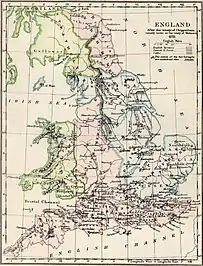Treaty of Alfred and Guthrum
The Treaty of Alfred and Guthrum is a 9th century peace agreement between Alfred of Wessex and Guthrum, the Viking ruler of East Anglia. It sets out the boundaries between Alfred and Guthrum's territories as well as agreements on peaceful trade, and the weregild value of its people.
Background
In 866 the Great Danish Army landed in East Anglia with the intention of conquering all the English kingdoms. During their campaign, the Viking army conquered the kingdoms of East Anglia, Mercia, and Northumbria and although initially, they overran the kingdom of Wessex, the Danish king Guthrum was defeated by Alfred's army at the Battle of Edington in 878.[1] Under the terms of his surrender, shortly after, Guthrum was obliged to be baptised[lower-alpha 1] and then with his army leave Wessex. The agreement whereby Guthrum surrendered, was baptised and agreed to leave Wessex is known as the Treaty of Wedmore.[3]
Sometime[lower-alpha 2] after Wedmore a treaty was agreed that set out the lasting peace terms between the two kings, this is known as the Treaty of Alfred and Guthrum. The treaty is one of the few existing documents[lower-alpha 3] of Alfred's reign; it survives in Old English in Corpus Christi College Cambridge Manuscript 383, and in a Latin compilation known as Quadripartitus. [6] [7]
The date when the treaty was created is not known for sure, but is believed to have been between 878[lower-alpha 2] and Guthrum's death in 890. [2]
The prologue to the treaty was a legitimization of the territory held by both parties. It legitimized the Danes landholdings in East Anglia and Alfred's in Mercia. [8] Clause 2 and 3 specify the blood money (or weregild), that is the value of men based on their status.[8] The other clauses are concerned with the purchase of men, horses and oxen. There is also provision for hostages as a guarantee of good faith for one side trading with the other.[9]
The treaty
The Laws of King Alfred
The original document was written in Old English, the following translation is by Frederick Attenborough
Prologue: These are the terms of peace which King Alfred and King Guthrum, and the councillors of all the English nation, and all the people who dwell in East Anglia, have all agreed upon and confirmed with oaths, on their own behalf and for their subjects both living and unborn, who are anxious for Gods favour and ours.
- First as to the boundaries between us. [They shall run] up the Thames, and then up[lower-alpha 4] the Lea, and along the Lea to its source, then in a straight line to Bedford, and then up the Ouse to Watling Street.
- Secondly, if a man is slain, whether he is an Englishman or a Dane, all of us shall place the same value on his life — namely 8 half-marks[lower-alpha 5] of pure gold, with the exception of commoners who occupy tributary land,[lower-alpha 6] and freedmen of the Danes. These also shall be valued at the same amount — [namely] 200 shillings — in either case.
- If anyone accuses a king's thegn of homicide, if he dares to clear himself, he shall do so with [the oaths of] twelve king's thegns. If anyone accuses a man who belongs to a lower order than that of king's thegn, he shall clear him-self with [the oaths of] eleven of his equals and one king's thegn. And this law shall apply to every suit which involves an amount greater than 4 mancusses. And if he [the accused] dare not [attempt to clear himself], he shall pay [as compensation] three times the amount at which the stolen property is valued.
- Every man shall have knowledge of his warrantor when he buys slaves, or horses, or oxen.
- And we all declared, on the day when the oaths were sworn, that neither slaves nor freemen should be allowed to pass over to the Danish host without permission, any more than that any of them [should come over] to us. If, however, it happens that any of them, in order to satisfy their wants, wish to trade with us, or we [for the same reason wish to trade] with them, in cattle and in goods, it shall be allowed on condition that hostages are given as security for peaceful behaviour, and as evidence by which it may be known that no treachery is intended.
See also
Notes
- Guthrum's baptismal name was Æthelstan on his conversion to Christianity in 878.[2]
- The actual date is not known. The treaty of Alfred and Guthrum ascribes Viking held London to Alfred, so some historians have suggested that the treaty would not have been finalised until Alfred reoccupied the city in 886. However the Anglo Saxon Chronicle for 885 says that "..the army from East-Anglia broke their peace with Alfred" which might indicate that the treaty had been signed earlier.[4]
- There are only three surviving documents from the Anglo-Saxon period that can be described as peace treaties.[5]
- See ASC 895 for meaning of 'up'[10]
- A mark was a Scandinavian weight about 3440-3520 grains.The troy pound is 5760 grains (≈ 373.24 g, 12 oz t), while an avoirdupois pound is approximately 21.53% heavier at 7000 grains (≈ 453.59 g).
- All of the ceorl class who do not farm land of their own.[6]
Citations
- Oliver 2012, pp. 169-177.
- Lapidge et al. 2001, p. 223.
- Attenborough 1922, pp. 96-101.
- Smyth 1995, pp. 92-93.
- Lavelle 2010, p. 325.
- Whitelock 1996, pp. 417-418.
- Asser 1983, p. 311.
- Lavelle 2010, p. 326.
- Smyth 1995, p. 93.
- Giles 1914, ASC 895.
Bibliography
- Asser (1983). "Life of King Alfred". In Keynes, Simon; Lapidge, Michael (eds.). Alfred the Great: Asser's Life of King Alfred & Other Contemporary Sources. Penguin Classics. ISBN 978-0-14-044409-4.CS1 maint: ref=harv (link)
- Attenborough, F.L. Tr, ed. (1922). "Treaties with the Danes". The laws of the earliest English kings. Cambridge: Cambridge University Press. OCLC 4296219.CS1 maint: ref=harv (link)
- Giles, J.A. (1914). . London: G. Bell and Sons Ltd. – via Wikisource.
- Lapidge, Michael; Blair, John; Keynes, Simon; Scragg, Donald, eds. (2001). The Blackwell Encyclopaedia of Anglo-Saxon England. London: Blackwell. ISBN 0-631-22492-0.CS1 maint: ref=harv (link)
- Lavelle, Ryan (2010). Alfred's Wars Sources and Interpretations of Anglo-Saxon Warfare in the Viking Age. Woodbridge, Suffolk: Boydel Press. ISBN 978-1-84383-569-1.CS1 maint: ref=harv (link)
- Oliver, Neil (2012). Vikings. A History. London: Weidenfeld & Nicolson. ISBN 978-0-297-86787-6.CS1 maint: ref=harv (link)
- Smyth, Alfred P. (1995). King Alfred the Great. Oxford: Oxford University Press. ISBN 0-19-822989-5.CS1 maint: ref=harv (link)
- Whitelock, Dorothy, ed. (1996). The treaty between Alfred and Guthrum. English Historical Documents. 1 (2 ed.). Oxford: Routledge. ISBN 0-203-43950-3.CS1 maint: ref=harv (link)

